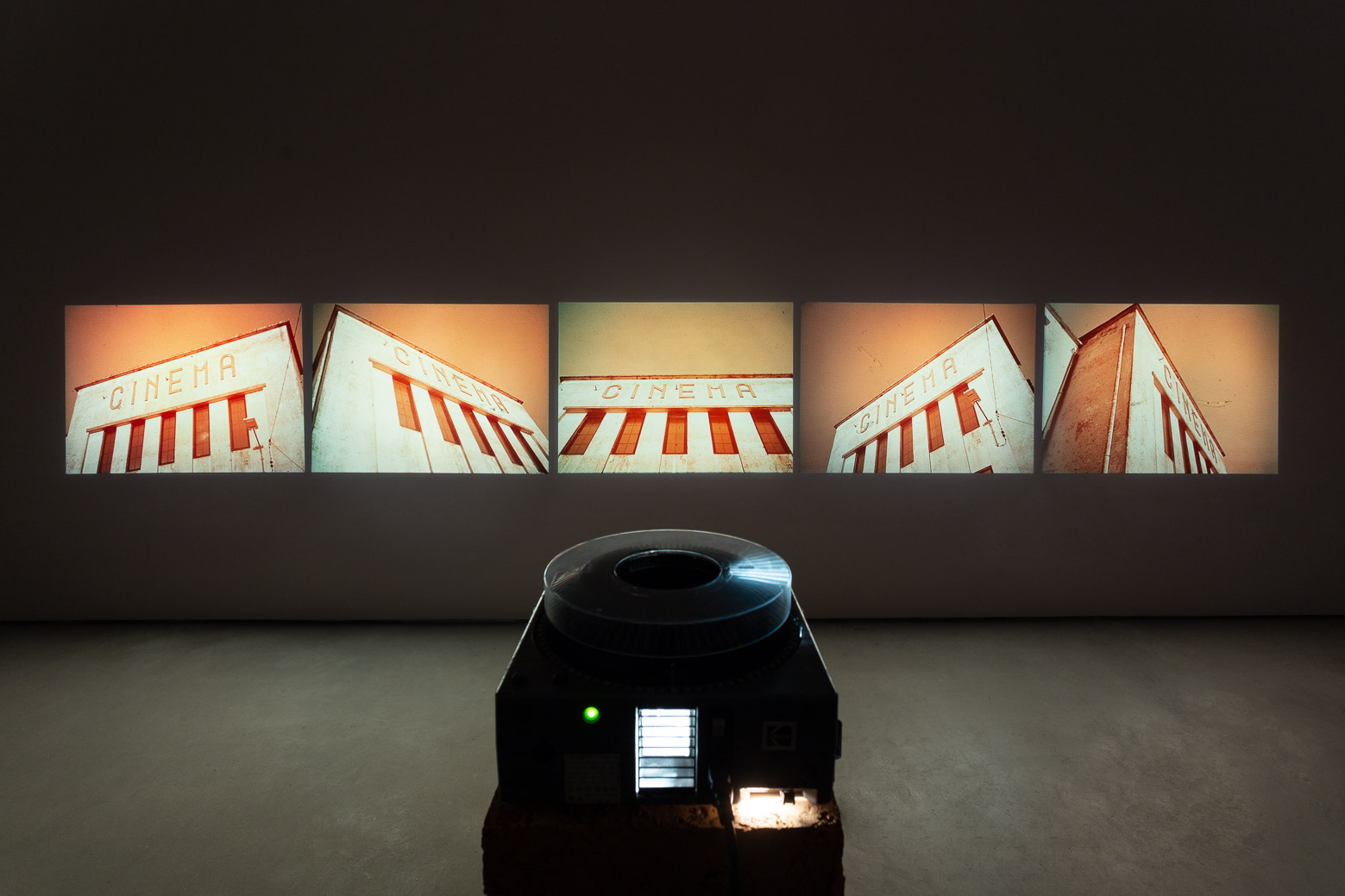








Red Flower – or Fire(1) - is the first exhibition by Henrique Pavão (Lisbon, 1991) at Galeria Bruno Múrias. The group of works expresses a transitory and renewal movement, anchored in a process of revisiting some of the artist’s previous questions. From this process, Pavão rescues the image of a fight between a tiger and a lion he had once found on youtube, where only an excerpt of the original film is available. Moved by the desire to access the full version of the movie, produced in the 1930s, the artist looked for a copy, which he eventually acquired. The violence portrayed in the film, capturing the instinctive action of survival between the two felines that fight to death, led the artist to destroy it.
From the 16mm film, there is only one frame remaining, the photograph The Adventure Parade: Lion Tiger Fight (2), as well as the ashes that rest inside each of the Red Flower (s). These objects, urns made of terracotta whose firing process in soenga was initiated by the sacrificed filmed itself, are replicas of pre-Columbian artifacts that are part of the collection of Museo Nacional de Arqueología (CDMX)(3). In their archaeological expression, the urns denote stages of a slow process that begins with the modeling and burning of the pieces – enriching their chromatic spectrum, with darker and more burnt parts contrasting with rawer and lighter ones, or less buffeted by the flame and the heat – to which is added a careful reconstruction. The restauration was caused by the fragmentation of the pieces under the soil and the effective masking of its parts, which led the artist to dig the burning site in order to find the lost pieces.
These almost archeologies share the central space of the exhibition with five projectors that show five photographs of Pavão of an old cinema in the village of Salvada (Alentejo, Portugal), built in the Estado Novo period, in the same decade when the feline fight was shot. The images that make up Shoshanna(4) are altered in their exhibition point in order to dialogue with the colour of the earth of Salvada and, in the projectors, placed in a way to undergo an even greater chromatic modification, the device burns them gradually with more exposure time. Both the Red Flower artifacts and the Shoshanna projectors are placed on flame-coloured rammed earth plinths, the same earth of Baixo Alentejo, where the movie theather is located and where the artist thought and conceived this project; it thus highlight the connections around the symbolic action of fire and burning.
(1) Red Flower is the euphemism chosen by Shere Khan, the fearsome tiger from Rudyard Kipling’s The Jungle Book (1894) to refer to fire, devaluating the element’s effects; they are just flowers, red flowers;
(2) The Adventure Parade: Lion Tiger Fight, here the title of Pavão’s work, is also the original title of the film destroyed by the artist.
(3) Zapotec and Mixtec civilizations, documented by the artist on a research trip to Mexico in 2019;
(4) The reference is Shoshanna Dreyfus, the cinema arsonist of the film Inglorious Basterds (2009), by Quentin Tarantino.
From the 16mm film, there is only one frame remaining, the photograph The Adventure Parade: Lion Tiger Fight (2), as well as the ashes that rest inside each of the Red Flower (s). These objects, urns made of terracotta whose firing process in soenga was initiated by the sacrificed filmed itself, are replicas of pre-Columbian artifacts that are part of the collection of Museo Nacional de Arqueología (CDMX)(3). In their archaeological expression, the urns denote stages of a slow process that begins with the modeling and burning of the pieces – enriching their chromatic spectrum, with darker and more burnt parts contrasting with rawer and lighter ones, or less buffeted by the flame and the heat – to which is added a careful reconstruction. The restauration was caused by the fragmentation of the pieces under the soil and the effective masking of its parts, which led the artist to dig the burning site in order to find the lost pieces.
These almost archeologies share the central space of the exhibition with five projectors that show five photographs of Pavão of an old cinema in the village of Salvada (Alentejo, Portugal), built in the Estado Novo period, in the same decade when the feline fight was shot. The images that make up Shoshanna(4) are altered in their exhibition point in order to dialogue with the colour of the earth of Salvada and, in the projectors, placed in a way to undergo an even greater chromatic modification, the device burns them gradually with more exposure time. Both the Red Flower artifacts and the Shoshanna projectors are placed on flame-coloured rammed earth plinths, the same earth of Baixo Alentejo, where the movie theather is located and where the artist thought and conceived this project; it thus highlight the connections around the symbolic action of fire and burning.
(1) Red Flower is the euphemism chosen by Shere Khan, the fearsome tiger from Rudyard Kipling’s The Jungle Book (1894) to refer to fire, devaluating the element’s effects; they are just flowers, red flowers;
(2) The Adventure Parade: Lion Tiger Fight, here the title of Pavão’s work, is also the original title of the film destroyed by the artist.
(3) Zapotec and Mixtec civilizations, documented by the artist on a research trip to Mexico in 2019;
(4) The reference is Shoshanna Dreyfus, the cinema arsonist of the film Inglorious Basterds (2009), by Quentin Tarantino.
Red Flower, 2021
Photo — Bruno Lopes
Image 3: Shoshanna, 2021
Kodak Carousel S-AV slide projector, slide (35mm, colour), rammed earth (5 units)
(5x) 110 x 28 x 28 cm
Image 5: The Adventure Parade: Lion Tiger Fight, 2021
Inkjet print on Photo Rag cotton paper (320 gr)
136 x 182 cm
Images 6 - 9: Red Flower, 2021
Terracotta, ashes, glass, rammed earth
(3x)140 x 28 x 28 cm
Video Documentation:
https://vimeo.com/1087984922
© 2025 Henrique Pavão